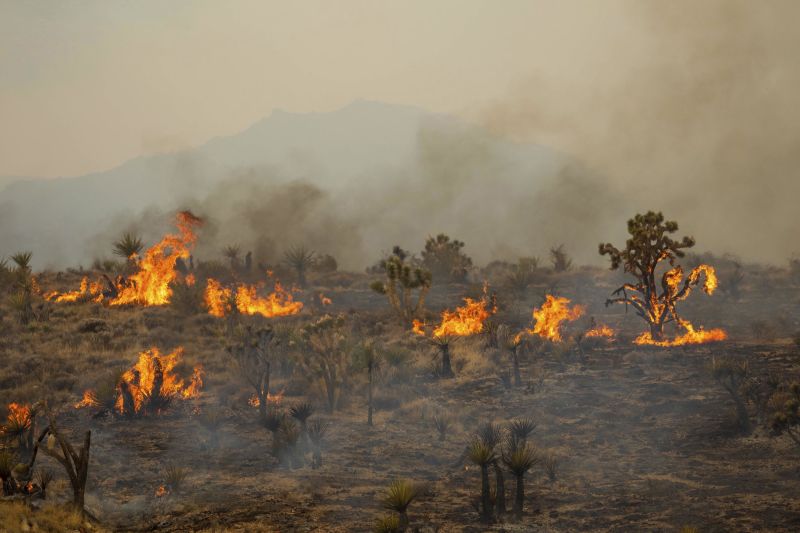A massive fire burning through the desert in California and southern Nevada has scorched tens of thousands of acres in a biodiverse national preserve and torched its iconic Joshua trees.
The York Fire – already California’s largest fire of the year – has burned more than 82,000 acres as of Wednesday morning, fire officials said. It began Friday in the New York Mountains of California’s Mojave National Preserve and crossed state lines into Nevada on Sunday.
The fire is burning through and threatening groves of Joshua trees – the branching, spiky plants of the Mojave Desert that can live more than 150 years.
“We’re looking at sad outcomes for potentially millions of Joshua trees,” Hanford said. “The fire is dramatically affecting the vegetation landscape.”
It’s unclear exactly how many Joshua trees and other plant and animal life had been lost to the blaze, a Mojave Preserve spokesperson said. Preserve rangers will conduct surveys by air and ground once the fire is extinguished to determine the full scope of the damage.
When it first began, the fire was fueled by extreme conditions that spawned fire whirls and 20-foot flames which made it dangerous and difficult to control.
Now, after a few rounds of rain moved over the area from Monday night to Wednesday morning, firefighters have been able to make progress along the fire’s border and it was 30% contained as of Wednesday morning.
But the damage to the landscape will last long after the flames are put out.
“This is pretty devastating,” Cunningham said.
The Mojave National Preserve has been seeing an increase in fire frequency over the past decade due to a combination of wet winters and increasing levels of invasive grasses, fire officials say on Inciweb, a clearinghouse for US fire information.
“If an area with Joshua trees burns through, most will not survive and reproduction in that area is made more difficult,” the National Park Service says. “Wildfires could also result in the loss of irreplaceable resources in the park, like historic structures and cultural artifacts.”
In 2020, a 43,273-acre wildfire burned through the Joshua tree woodland of California’s Cima Dome, destroying as many as 1.3 million Joshua trees and leaving behind a plant graveyard, according to the National Park Service.
Firefighters braving intense desert heat to stop the York Fire’s spread in the Mojave National Preserve are among more than 11,000 wildland firefighters and personnel assigned across the country, the National Interagency Fire Center said Tuesday.
Sixty-seven active, large fires were burning in 11 states as hot and dry conditions persist throughout the US, the center said Tuesday. More than 1.1 million acres have burned across the US in 2023 as of Tuesday, the center said.
Emerging desert tortoises pose unique challenge
Firefighters were aided by a brief but heavy downpour early Tuesday and more rain on Wednesday as they worked to contain the York Fire.
But rain in the Mojave Desert, which is seasonal and scarce, “poses a unique challenge to firefighters,” the Mojave National Preserve said.
Desert tortoises – federally listed as a threatened species – become especially active on wet summer days, emerging from their burrows to drink rainwater.
“Fire crews carefully balance fire suppression with resource protection. They will be on the lookout for desert tortoises, making sure to avoid burrows and active individuals,” the Mojave National Preserve said.
The good news is that most desert wildlife can move to safety when fire approaches, park officials said.
“Resource staff at Mojave National Preserve anticipate that the York Fire has caused minimal damage to critical tortoise habitat and has likely affected few individuals since tortoise observations in the fire area are rare,” preserve staff said.

